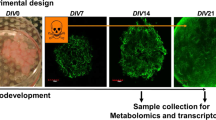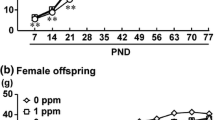Abstract
Tris(1,3-dichloro-2-propyl) phosphate (TDCPP) is a phosphorus-based flame retardant common in consumer goods and baby products. Concerns have been raised about TDCPP exposure and neurodevelopmental toxicity. However, the mechanism and early response for TDCPP-induced neurotoxicity are poorly understood. This study investigates the role of microglia-mediated neuroinflammation in TDCPP-induced neurotoxicity in mice and primary cells. TDCPP was administered to C57BL/6 pups (0, 5, or 50 mg/kg/day) via an oral gavage from postnatal days 10–38 (28 days). The results showed that TDCPP exposure for 28 days altered the gene expression of neuronal markers Tubb3, Nefh, and Nes, and led to apoptosis in the hippocampus. The mRNA levels of pro-inflammatory factors Il-1β, Tnfα and Ccl2 dose dependently increased in the hippocampus at both 24 h and 28 days following exposure, accompanied by microglia activation characterized by an amoeboid-like phenotype. In in vitro studies using the primary microglia isolated from neonatal mice, exposure to TDCPP (0–100 μM) for 24 h resulted in cellular activation. It also increased the expression of genes responsible for inflammatory responses including surface markers and pro-inflammatory cytokines. These changes occurred in a dose-dependent fashion. Neurite outgrowth of primary mouse hippocampal neurons was inhibited by treatment with the conditioned medium harvested from microglia exposed to TDCPP. These results reveal that neonatal exposure to TDCPP induces neuronal damage through microglia-mediated inflammation. This provides insight into the mechanism of TDCPP’s neurodevelopmental toxicity, and suggests that microglial cell is a sensitive responder for OPFRs exposure.









Similar content being viewed by others
References
Beggs S, Salter MW (2016) SnapShot: microglia in disease. Cell 165(5):1294–1294 e1. https://doi.org/10.1016/j.cell.2016.05.036
Biber K, Owens T, Boddeke E (2014) What is microglia neurotoxicity (Not)? Glia 62(6):841–854. https://doi.org/10.1002/glia.22654
Bilbo S, Stevens B (2017) Microglia The Brain’s First Responders. Cerebrum
Block ML, Zecca L, Hong JS (2007) Microglia-mediated neurotoxicity: uncovering the molecular mechanisms. Nat Rev Neurosci 8(1):57–69. https://doi.org/10.1038/nrn2038
Bott CJ, Johnson CG, Yap CC, Dwyer ND, Litwa KA, Winckler B (2019) Nestin in immature embryonic neurons affects axon growth cone morphology and Semaphorin3a sensitivity. Mol Biol Cell 30(10):1214–1229. https://doi.org/10.1091/mbc.E18-06-0361
Brown GC, Vilalta A (2015) How microglia kill neurons. Brain Res 1628(Pt B):288–297. https://doi.org/10.1016/j.brainres.2015.08.031
Buchanan MM, Hutchinson M, Watkins LR, Yin H (2010) Toll-like receptor 4 in CNS pathologies. J Neurochem 114(1):13–27. https://doi.org/10.1111/j.1471-4159.2010.06736.x
Butovsky O, Weiner HL (2018) Microglial signatures and their role in health and disease. Nat Rev Neurosci 19(10):622–635. https://doi.org/10.1038/s41583-018-0057-5
Butt CM, Congleton J, Hoffman K, Fang M, Stapleton HM (2014) Metabolites of organophosphate flame retardants and 2-ethylhexyl tetrabromobenzoate in urine from paired mothers and toddlers. Environ Sci Technol 48(17):10432–10438. https://doi.org/10.1021/es5025299
Butt CM, Hoffman K, Chen A, Lorenzo A, Congleton J, Stapleton HM (2016) Regional comparison of organophosphate flame retardant (PFR) urinary metabolites and tetrabromobenzoic acid (TBBA) in mother-toddler pairs from California and New Jersey. Environ Int 94:627–634. https://doi.org/10.1016/j.envint.2016.06.029
Cowan M, Petri WA Jr (2018) Microglia: immune regulators of neurodevelopment. Front Immunol 9:2576. https://doi.org/10.3389/fimmu.2018.02576
Davoli MA, Fourtounis J, Tam J et al (2002) Immunohistochemical and biochemical assessment of caspase-3 activation and DNA fragmentation following transient focal ischemia in the rat. Neuroscience 115(1):125–136. https://doi.org/10.1016/s0306-4522(02)00376-7
Deng WJ, Li N, Wu R, Richard WKS, Wang Z, Ho W (2018) Phosphorus flame retardants and bisphenol A in indoor dust and PM2.5 in kindergartens and primary schools in Hong Kong. Environ Pollut 235:365–371. https://doi.org/10.1016/j.envpol.2017.12.093
Ding J, Xu Z, Huang W, Feng L, Yang F (2016) Organophosphate ester flame retardants and plasticizers in human placenta in Eastern China. Sci Total Environ 554–555:211–217. https://doi.org/10.1016/j.scitotenv.2016.02.171
Dishaw LV, Hunter DL, Padnos B, Padilla S, Stapleton HM (2014) Developmental exposure to organophosphate flame retardants elicits overt toxicity and alters behavior in early life stage zebrafish (Danio rerio). Toxicol Sci 142(2):445–454. https://doi.org/10.1093/toxsci/kfu194
Doherty BT, Hoffman K, Keil AP et al (2019) Prenatal exposure to organophosphate esters and behavioral development in young children in the pregnancy, infection, and nutrition study. Neurotoxicology 73:150–160. https://doi.org/10.1016/j.neuro.2019.03.007
Fontes K, Rohlicek CV, Saint-Martin C et al (2019) Hippocampal alterations and functional correlates in adolescents and young adults with congenital heart disease. Hum Brain Mapp 40(12):3548–3560. https://doi.org/10.1002/hbm.24615
Fromme H, Lahrz T, Kraft M et al (2014) Organophosphate flame retardants and plasticizers in the air and dust in German daycare centers and human biomonitoring in visiting children (LUPE 3). Environ Int 71:158–163. https://doi.org/10.1016/j.envint.2014.06.016
Gusel’nikova VV, Korzhevskiy DE (2015) NeuN as a neuronal nuclear antigen and neuron differentiation marker. Acta Naturae 7(2):42–47
Hanisch UK, Kettenmann H (2007) Microglia: active sensor and versatile effector cells in the normal and pathologic brain. Nat Neurosci 10(11):1387–1394. https://doi.org/10.1038/nn1997
Heindl S, Gesierich B, Benakis C, Llovera G, Duering M, Liesz A (2018) Automated morphological analysis of microglia after stroke. Front Cell Neurosci 12:106. https://doi.org/10.3389/fncel.2018.00106
Hendriks HS, Koolen LA, Dingemans MM et al (2015) Effects of neonatal exposure to the flame retardant tetrabromobisphenol-A, aluminum diethylphosphinate or zinc stannate on long-term potentiation and synaptic protein levels in mice. Arch Toxicol 89(12):2345–2354. https://doi.org/10.1007/s00204-014-1366-8
Hoffman K, Butt CM, Chen A, Limkakeng AT Jr, Stapleton HM (2015) High exposure to organophosphate flame retardants in infants: associations with baby products. Environ Sci Technol 49(24):14554–14559. https://doi.org/10.1021/acs.est.5b03577
Hong X, Chen R, Hou R, Yuan L, Zha J (2018) Triphenyl phosphate (TPHP)-induced neurotoxicity in adult male Chinese rare minnows (Gobiocypris rarus). Environ Sci Technol 52(20):11895–11903. https://doi.org/10.1021/acs.est.8b04079
Ji C, Yan L, Chen Y et al (2019) Evaluation of the developmental toxicity of 2,7-dibromocarbazole to zebrafish based on transcriptomics assay. J Hazard Mater 368:514–522. https://doi.org/10.1016/j.jhazmat.2019.01.079
Li R, Zhou P, Guo Y, Lee JS, Zhou B (2017) Tris (1,3-dichloro-2-propyl) phosphate-induced apoptotic signaling pathways in SH-SY5Y neuroblastoma cells. Neurotoxicology 58:1–10. https://doi.org/10.1016/j.neuro.2016.10.018
Lian H, Roy E, Zheng H (2016) Protocol for primary microglial culture preparation. Bio Protoc. https://doi.org/10.21769/BioProtoc.1989
Matcovitch-Natan O, Winter DR, Giladi A et al (2016) Microglia development follows a stepwise program to regulate brain homeostasis. Science 353(6301):aad8670. https://doi.org/10.1126/science.aad8670
McCarthy GM, Bridges CR, Blednov YA, Harris RA (2017) CNS cell-type localization and LPS response of TLR signaling pathways. F1000Res 6:1144. https://doi.org/10.12688/f1000research.12036.1
Moser VC, Phillips PM, Hedge JM, McDaniel KL (2015) Neurotoxicological and thyroid evaluations of rats developmentally exposed to tris(1,3-dichloro-2-propyl)phosphate (TDCIPP) and tris(2-chloro-2-ethyl)phosphate (TCEP). Neurotoxicol Teratol 52(Pt B):236–247. https://doi.org/10.1016/j.ntt.2015.08.004
Kamata E, Naito K, Nakaji Y, et al. (1989) Acute and subacute toxicity studies of tris (1,3-dichloro-2-propyl) phosphate on mice. Eisei Shikenjo Hokoku (107):36–43
OECD (2008) Guidelines for the testing chemicals Test No. 407. Repeated dose 28-day oral toxicity study in rodents. https://doi.org/10.1787/9789264070684-en
RamaRao G, Acharya JN, Bhattacharya BK (2011) Changes of protein oxidation, calpain and cytoskeletal proteins (alpha tubulin and pNF-H) levels in rat brain after nerve agent poisoning. Toxicol Lett 203(3):227–236. https://doi.org/10.1016/j.toxlet.2011.03.020
Saponaro C, Cianciulli A, Calvello R, Dragone T, Iacobazzi F, Panaro MA (2012) The PI3K/Akt pathway is required for LPS activation of microglial cells. Immunopharmacol Immunotoxicol 34(5):858–865. https://doi.org/10.3109/08923973.2012.665461
Seibenhener ML, Wooten MW (2012) Isolation and culture of hippocampal neurons from prenatal mice. J Vis Exp. https://doi.org/10.3791/3634
Stapleton HM, Allen JG, Kelly SM et al (2008) Alternate and new brominated flame retardants detected in U.S. house dust. Environ Sci Technol 42(18):6910–6916
Sundkvist AM, Olofsson U, Haglund P (2010) Organophosphorus flame retardants and plasticizers in marine and fresh water biota and in human milk. J Environ Monit 12(4):943–951. https://doi.org/10.1039/b921910b
Tan H, Peng C, Guo Y, Wang X, Wu Y, Chen D (2017) Organophosphate flame retardants in house dust from South China and related human exposure risks. Bull Environ Contam Toxicol 99(3):344–349. https://doi.org/10.1007/s00128-017-2120-8
Tejera D, Heneka MT (2016) Microglia in Alzheimer’s disease: the good, the bad and the ugly. Curr Alzheimer Res 13(4):370–380
Thomas MB, Stapleton HM, Dills RL, Violette HD, Christakis DA, Sathyanarayana S (2017) Demographic and dietary risk factors in relation to urinary metabolites of organophosphate flame retardants in toddlers. Chemosphere 185:918–925. https://doi.org/10.1016/j.chemosphere.2017.07.015
Wang Q, Lai NL, Wang X et al (2015) Bioconcentration and transfer of the organophosphorous flame retardant 1,3-dichloro-2-propyl phosphate causes thyroid endocrine disruption and developmental neurotoxicity in zebrafish larvae. Environ Sci Technol 49(8):5123–5132. https://doi.org/10.1021/acs.est.5b00558
Wei Y, Gong J, Xu Z et al (2015) Nrf2 in ischemic neurons promotes retinal vascular regeneration through regulation of semaphorin 6A. Proc Natl Acad Sci USA 112(50):E6927–E6936. https://doi.org/10.1073/pnas.1512683112
Xing X, Kang J, Qiu J et al (2018) Waterborne exposure to low concentrations of BDE-47 impedes early vascular development in zebrafish embryos/larvae. Aquat Toxicol 203:19–27. https://doi.org/10.1016/j.aquatox.2018.07.012
Yao L, Kan EM, Lu J et al (2013) Toll-like receptor 4 mediates microglial activation and production of inflammatory mediators in neonatal rat brain following hypoxia: role of TLR4 in hypoxic microglia. J Neuroinflammation 10:23. https://doi.org/10.1186/1742-2094-10-23
Yin SY, Chen L, Wu DY et al (2019) Tris(1,3-dichloro-2-propyl) phosphate (TDCPP) disturbs mouse embryonic development by inducing apoptosis and abnormal DNA methylation. Environ Mol Mutagen. https://doi.org/10.1002/em.22322
Yuan L, Li J, Zha J, Wang Z (2016) Targeting neurotrophic factors and their receptors, but not cholinesterase or neurotransmitter, in the neurotoxicity of TDCPP in Chinese rare minnow adults (Gobiocypris rarus). Environ Pollut 208(Pt B):670–677. https://doi.org/10.1016/j.envpol.2015.10.045
Zhan Y, Paolicelli RC, Sforazzini F et al (2014) Deficient neuron-microglia signaling results in impaired functional brain connectivity and social behavior. Nat Neurosci 17(3):400–406. https://doi.org/10.1038/nn.3641
Zhang T, Bai XY, Lu SY et al (2018) Urinary metabolites of organophosphate flame retardants in China: health risk from tris(2-chloroethyl) phosphate (TCEP) exposure. Environ Int 121:1363–1371. https://doi.org/10.1016/j.envint
Zhong X, Kang J, Qiu J et al (2019a) Developmental exposure to BDE-99 hinders cerebrovascular growth and disturbs vascular barrier formation in zebrafish larvae. Aquat Toxicol 214:105224. https://doi.org/10.1016/j.aquatox.2019.105224
Zhong X, Qiu J, Kang J, Xing X, Shi X, Wei Y (2019b) Exposure to tris(1,3-dichloro-2-propyl) phosphate (TDCPP) induces vascular toxicity through Nrf2-VEGF pathway in zebrafish and human umbilical vein endothelial cells. Environ Pollut 247:293–301. https://doi.org/10.1016/j.envpol.2018.12.066
Acknowledgements
We would like to thank Professor Wen Chen (Sun Yat-sen University) for her suggestions and technical assistance. This work was supported by the National Natural Science Foundation of China (21777199), the National Key R&D program (2017YFC1600205), the 100 Top Talents Program of Sun Yat-sen University and the “Fundamental Research Funds for the Central Universities (18ykzd06 and 19ykpy92)”.
Author information
Authors and Affiliations
Corresponding author
Ethics declarations
Conflict of interest
The authors declare that they have no conflict of interest.
Ethical approval
All animal experiments were performed according to the Chinese guidelines for care and use of laboratory animals, and were approved by the Ethical Committee for Animal Experimentation at Sun Yat-Sen University.
Additional information
Publisher's Note
Springer Nature remains neutral with regard to jurisdictional claims in published maps and institutional affiliations.
Rights and permissions
About this article
Cite this article
Zhong, X., Wu, J., Ke, W. et al. Neonatal exposure to organophosphorus flame retardant TDCPP elicits neurotoxicity in mouse hippocampus via microglia-mediated inflammation in vivo and in vitro. Arch Toxicol 94, 541–552 (2020). https://doi.org/10.1007/s00204-019-02635-y
Received:
Accepted:
Published:
Issue Date:
DOI: https://doi.org/10.1007/s00204-019-02635-y




